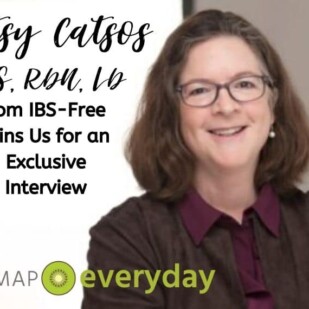Erica Ilton RDN CDN Interview
In our on-going Interview series, we have brought you the RDNs of our Success Team as well as the movers and shakers within the low FODMAP universe.
This article highlights Erica Ilton, RDN, CDN who is in private practice in New York City. Very recently she was a Clinical Nutrition Coordinator in the Department of Gastroenterology at Mount Sinai Hospital, and prior to that, she was a Senior Nutritionist at Joy Bauer Nutrition.
She has expertise in both adult and pediatric gastrointestinal disorders, and a special interest in where the low FODMAP diet intersects with SIBO and inflammatory bowel disease. We sat down with her to chat about FODMAPs and more.
Erica is part of our Success Team Leader here at FODMAP Everyday®! To learn more about her you can check out her bio here – where you also find her contact information if you would like to work with her!
Dédé: Erica, thank you for doing this interview! You first came to our attention when we cast a wide net out there to all the RDNs who had self-identified as being involved with the low FODMAP diet. Tell us how you first became aware of the diet?

Two years later, after a Google search of the word “FODMAP” yielded 916,000 results, I knew it was time for another PowerPoint! This time, all the docs had heard about the diet, and many had already begun referring patients to me for low FODMAP education.
FYI – as of one minute ago, Google spit out 18,500,000 results when fed the word “FODMAP!”
Tell us about your FODMAP program for irritable bowel syndrome (IBS).
Like the diet itself, my FODMAP program for IBS has evolved over time. Changes have primarily involved adding newly tested items to my food lists, and updating previously tested ones, such as bananas (recently “downgraded,” much to my dismay). I also try to stay on top of the research − both FODMAP- and IBS-related – in order to keep my educational material current.
The basic format remains the same, however, and includes an elimination phase, a reintroduction/challenge phase, and a personalized “FODMAP-for-life” phase.
Oh, I like that “FODMAP-for-life” terminology! We like to call that our Integration phase because it truly is about helping people integrate their newfound knowledge into their everyday lives.
In terms of the low FODMAP diet, what has been the biggest challenge for your clients? Do you think it’s general comprehension of what the diet is? Or is it more practical, like, what they can eat, and how to go about shopping, cooking, etc.?
Definitely the latter, i.e., the more practical aspects of the diet. I think/hope I do a good job explaining the FODMAP concept, but understanding how and why something works can be a breeze compared to putting that knowledge into everyday practice.
One of the biggest obstacles my clients face is eating out. And they do that a lot because most of them live in New York City, where kitchens are teensy, take-out is the norm, and restaurants are plentiful. I hope the great recipes featured on FODMAP Everyday will inspire a few of them to start preparing at least some of their meals at home!
And they can use our filter to search for Quick and Easy recipes and Monash University Certified Low FODMAP Recipes as a great start.
While all of us in the FODMAP world are still trying to educate people to that acronym, SIBO is also bursting onto the scene. Help our readers understand SIBO and how is it diagnosed.
Like FODMAP, the word itself is an acronym: Small Intestinal Bacterial Overgrowth. Now you know why we refer to it as SIBO!
Intestinal bacteria are normal and necessary, but these critters are supposed to live mainly in the large intestine. If too many decide to take up residence in the small intestine, symptoms such as upper gastrointestinal (GI) bloating and distention, diarrhea, and constipation will follow.
In more extreme cases of SIBO, vitamin and mineral deficiencies, weight loss, and malnutrition can also occur.
SIBO is typically diagnosed by a breath test, but some doctors go straight to treatment if a person’s symptoms are classic for the condition. While this may seem alarming, the empirical approach is sometimes a better option because breath tests can be unreliable and are frequently misinterpreted, and because the treatment itself is usually well-tolerated.
What causes SIBO?
Healthy individuals maintain a number of defenses that protect against SIBO, but if these mechanisms are compromised, the small intestine becomes susceptible to bacterial invasion.
Among the many conditions that predispose a person to developing SIBO are long-term use of proton pump inhibitors (PPI’s), gut motility disturbances, and certain types of intestinal surgery.
Diagnosing and treating the underlying cause of SIBO is the ideal intervention, but is often not possible. Whether or not the cause is determined, therapy for SIBO involves killing off excess small intestinal bacteria with an anti-microbial agent and then cutting off their food supply.
Tell us how you incorporate the low FODMAP diet for those diagnosed with SIBO.
Similar to my IBS plan, my SIBO program also utilizes the low FODMAP diet. However, depending on the individual, I may need to customize the diet even further.
Treatment of SIBO also differs from that of IBS in that excess small intestinal bacteria should be eliminated before dietary changes are implemented.
Typically, this involves prescription antibiotics, but various non-pharmaceutical antimicrobials, as well as a specialized liquid diet, are also effective.
And just to be super thorough, I should mention that spacing meals 3 to 4 hours apart is important because it allows the gut’s cleansing waves — known as the migrating motor complex, or MMC — to sweep bacteria out of the small intestine.
Likewise, some people benefit from taking a prescription or herbal prokinetic (motility agent that stimulates the MMC) while on the diet.
For many outside of the medical gastroenterology community, there is often confusion about IBS and IBD (inflammatory bowel disease). Can you explain the difference, and describe how and when they occur simultaneously?
This is a very important distinction, so I’m glad you asked.
IBS is referred to as a functional GI disorder, i.e., blood labs, colonoscopies, and other diagnostic tests fail to show anything wrong, but something is clearly “off” in the way the large intestine is functioning.
IBS is often considered to be a diagnosis of exclusion, meaning that many doctors only rule it in after ruling out conditions that cause similar symptoms…such as IBD.
IBD encompasses two primary conditions − Ulcerative Colitis and Crohn’s disease. Both are organic GI disorders because unlike in IBS, diagnostic tests reveal a range of biochemical and physical abnormalities in people with IBD.
When the two conditions occur simultaneously, it’s sometimes called “IBD with IBS overlay,” or “IBD with IBS overlap.” This describes the phenomenon of persistent symptoms in a person whose IBD is in remission.
In other words, the biochemical and physical manifestations of IBD are under control, but symptoms consistent with both conditions − typically non-bloody diarrhea, bloating, or pain − remain.
What do you do for someone who has “IBD with IBS overlay”? Does the low FODMAP diet play a part?
In a word, YES! I essentially treat the person as if they have IBS (which they do) while always remaining mindful of their primary diagnosis. That means I make sure they know the “red flag” symptoms that might indicate an IBD flare, and I insist that they continue to follow the protocol laid out by their IBD specialist.
I also continue to advocate any additional IBD-specific dietary restrictions that may be necessary.
Furthermore, I’m even more adamant about reintroducing higher-FODMAP items in this population, because the prebiotic effect of many of these foods is particularly important for people with IBD.
Are there other diagnoses that you find are helped by the low FODMAP diet?
You mean IBS, SIBO, and IBD are not enough?!
But really, I do sometimes use the low FODMAP diet for other conditions, including functional bloating/distention, and functional constipation or diarrhea.
We know that you were very recently at Mount Sinai, and now will be turning your focus to your individual practice. Tell us more about that, and we’ll make sure folks can find you for a consultation!
I’ve been in private practice for ages, actually, including when I was also at Mount Sinai. The main difference now is that in addition to seeing people in my physical office, I’ll soon be starting a telehealth practice so I can help people who can’t or won’t commute to New York City.
I’m also much more zeroed in on gastrointestinal disorders now than when I began practicing nutrition. I do still see people with weight concerns and various other conditions, such as osteoporosis, PCOS, and metabolic syndrome, but my primary focus is the 30-or-so feet that comprise the GI tract.
That means I work with people who have IBS, SIBO, gastroparesis and other functional and motility conditions, as well as celiac disease, Crohn’s disease, ulcerative colitis, and gastroesophageal reflux disease (GERD). I’m sure I left something out, but you get the picture!







